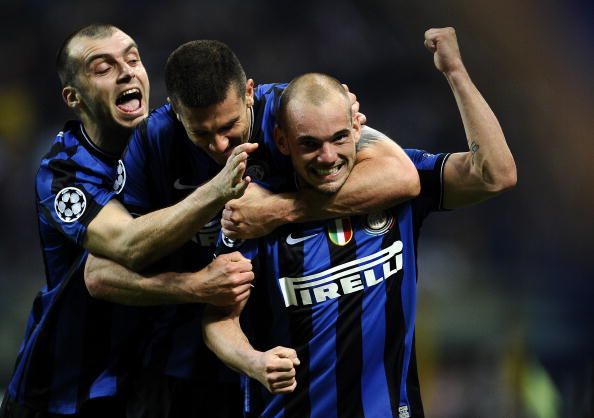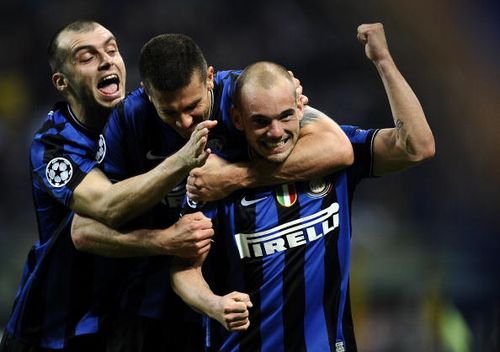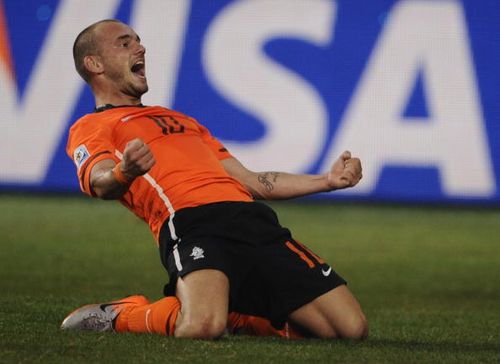
The Fall of Wesley Sneijder

In 2010, Jose Mourinho’s all-conquering Internazionale side achieved an unprecedented treble. They won the Serie A title for a fifth consecutive year, and they also won the Coppa Italia for the first time in four years, beating Roma in the final. But neither of these two trophies compared to Mourinho’s party piece – the Champions League triumph. Not only did Inter beat the great Barcelona side over two legs, but they also went on to outplay an excellent Bayern Munich side in the final 2-0. At the centre of this triumph was the spine of Julio Cesar, Lucio, Diego Milito and the magnificent Dutch lynchpin in midfield, Wesley Sneijder.
Considering the sheer panache and deftness of touch the Dutch talisman displayed on the grand stage of the UEFA’s jewel club competition, it was almost certain that he would be earmarked for a big money move to either Real Madrid or Manchester United in the summer. If the rumours were whispered before the biggest sporting event of the year – the FIFA World Cup – they became deafening afterwards, when Sneijder became the joint top scorer in the tournament and inspired the Netherlands to reach their first World Cup final in 32 years.

Sneijder was on top of the world. He finished fourth in the Ballon d’Or behind only the great Lionel Messi and the dynamic Spanish duo of Xavi and Iniesta. Realising that every team after a number 10 magician would fight tooth and claw for their man, Inter offered him a huge contract with a £4.8 million annual wage and an extra £800,000 bonus. Sneijder was here to stay and all seemed well in the Dutchman’s camp. In reality, this was to be the high point of his career.
When Mourinho left for Madrid, Sneijder’s body failed him, and hampered by injuries throughout the 2010-11 season, Inter lost their grip on Serie A. The side’s form capitulated even more last season, as they finished in a catastrophic sixth place with Sneijder an utter shadow of the man who gracefully picked apart defences with ease two years ago.
The form that Sneijder had lost had by no means vanished forever, but the extremely lucrative contract he signed two years was to be the most calamitous decision he’d make. Inter’s wage bill was ludicrously high, meaning that with the fabled ‘Financial Fair Play’ regulations coming into effect soon, Inter could be banned from Europe for the foreseeable future. Big names such as Cesar, Maicon and Samuel Eto’o all found new clubs, but Sneijder, the biggest earner of them all, still had two years left. Still a valuable player, sporting director Marco Branca begged his star to take a big pay cut to ease the strain, but Sneijder refused. Since that fateful decision, Sneijder has been rooted to the bench even though his teammates are suggesting his form in training is back to his 2010 best.

Two years ago, teams were cuing up to whisper their promises of glory to the Dutchman in a desperate attempt to lure him away from the San Siro. Now, we can’t put it past Inter to start sending press releases to every club saying how wonderful their man is to try and entice them to take a gambit on the maestro. His excessive wage demands and newly discovered injury concerns mean that sides aren’t prepared to take the risk on the 28-year old even at the bargain price of £12 million. Inter have made it clear that they no longer want him at the club and so the endless cycle of games on the bench continues.
While the proverb ‘form is temporary, class is permanent’ may yet prove to be correct for the Dutchman, external factors have forced him into a freezer, unable to escape, stuck in limbo. Once one of the game’s great talents, Sneijder now can’t even get into a side struggling to reach the heights achieved by Juventus and teams in light blue. It’ll be a shame if Sneijder fails to rediscover the class that lit up Europe in 2010 – the story of Andrea Pirlo can certainly give him hope – but his dramatic fall from grace can offer inspiring footballers some valuable knowledge. Sometimes you can have too much too soon.